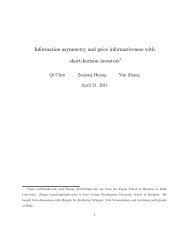Does Enforcement of Intellectual Property Rights Matter in China ...
Does Enforcement of Intellectual Property Rights Matter in China ...
Does Enforcement of Intellectual Property Rights Matter in China ...
You also want an ePaper? Increase the reach of your titles
YUMPU automatically turns print PDFs into web optimized ePapers that Google loves.
to ensure that the analysis focuses on relatively substantial f<strong>in</strong>anc<strong>in</strong>g events. More than 47% <strong>of</strong> firmyear<br />
observations have raised new debt.<br />
Second, we analyze bank loan and <strong>in</strong>formal f<strong>in</strong>anc<strong>in</strong>g separately. S<strong>in</strong>ce <strong>in</strong>formation on detailed<br />
debt structure is limited, we compute the <strong>in</strong>formal f<strong>in</strong>anc<strong>in</strong>g ratio as the net <strong>in</strong>crease <strong>of</strong> all debt <strong>in</strong> a<br />
given year m<strong>in</strong>us the net change <strong>in</strong> bank loan and net change <strong>in</strong> trade credit, divided by the net<br />
<strong>in</strong>crease <strong>of</strong> all debt. MOST dataset does not disclose the trade credit <strong>of</strong> <strong>in</strong>dividual firms, so we use<br />
<strong>in</strong>stead, the median ratio <strong>of</strong> new trade credit to the net <strong>in</strong>crease <strong>of</strong> all debt for the listed companies <strong>in</strong><br />
the same <strong>in</strong>dustry-year, <strong>in</strong> the follow<strong>in</strong>g calculation:<br />
Debt - Bank Loan Trade Credit<br />
Informal F<strong>in</strong>anc<strong>in</strong>g Ratio <br />
-( )<br />
Debt<br />
Debt<br />
same <strong>in</strong>dustry- year<br />
The classification <strong>of</strong> <strong>in</strong>dustry is from Industry Classification Standard by CSRC (Ch<strong>in</strong>a Securities<br />
Regulatory Commission). If net new total debt is less than the sum <strong>of</strong> new bank loan and new trade<br />
credit <strong>in</strong> a year, the <strong>in</strong>formal f<strong>in</strong>anc<strong>in</strong>g ratio is negative, i.e., the firm repays previous borrow<strong>in</strong>g<br />
from <strong>in</strong>formal sources with new bank loans and new trade credit. If the sum <strong>of</strong> new bank loan and<br />
new trade credit is negative and net new total debt is positive, <strong>in</strong>formal f<strong>in</strong>anc<strong>in</strong>g is the source <strong>of</strong><br />
funds to pay back previous bank loan and trade credit. In this case, the <strong>in</strong>formal f<strong>in</strong>anc<strong>in</strong>g ratio is<br />
larger than 1. Because the <strong>in</strong>formation on bank loan is available only <strong>in</strong> 2004 and 2005, this portion<br />
<strong>of</strong> the analysis is limited to these two years. We only calculate the <strong>in</strong>formal f<strong>in</strong>anc<strong>in</strong>g ratio for the<br />
firms that raised new debt exceed<strong>in</strong>g 5% <strong>of</strong> their total assets. We have 6,487 firm-year observations<br />
with <strong>in</strong>formal f<strong>in</strong>anc<strong>in</strong>g ratios.<br />
As shown <strong>in</strong> Table 1 (Panel A), 28.5% <strong>of</strong> new debt comes from <strong>in</strong>formal f<strong>in</strong>anc<strong>in</strong>g. The<br />
calculation only <strong>in</strong>cludes firms that raised new debt exceed<strong>in</strong>g 5% <strong>of</strong> their total assets. Informal<br />
f<strong>in</strong>anc<strong>in</strong>g ratio <strong>in</strong> the total sample is about 12%. This number is higher than the average percentage<br />
17



